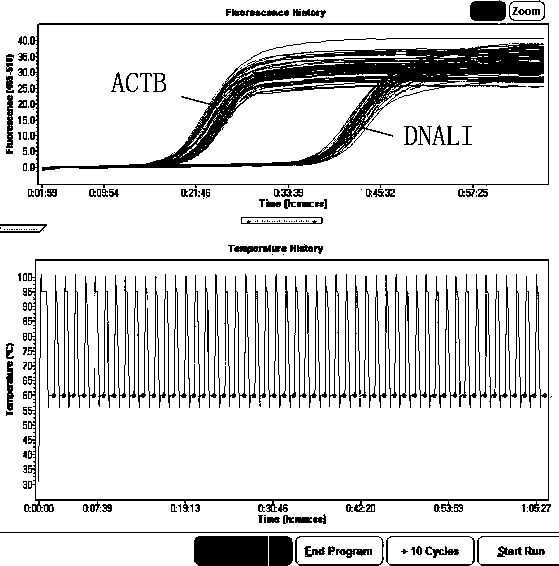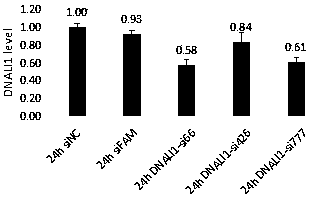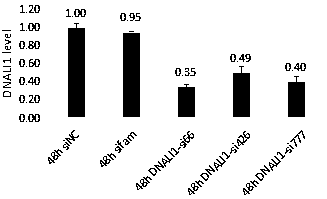siRNA for interfering DNALI1 gene expression and application of siRNA in cell proliferation and migration inhibition
A technology of gene expression and cell inhibition, applied in the field of molecular genetics to reduce or prevent diseases
- Summary
- Abstract
- Description
- Claims
- Application Information
AI Technical Summary
Problems solved by technology
Method used
Image
Examples
Embodiment 1
[0035] Embodiment 1: Design and synthesis of interfering RNA (siRNA) target sequence
[0036] The DNALI1 gene sequence was obtained from GenBank. According to the siRNA design principle, three interference target sequences were designed and synthesized by screening the conserved region of the DNALI1 gene sequence, named DNALI1-siRNA-66, DNALI1-siRNA-426, and DNALI1-siRNA-777, respectively. At the same time, a nonsense sequence not targeting any gene was designed as a negative control (siFAM), and the sequence is shown in Table 1.
[0037] Table 1 siRNA sequence design and synthesis
[0038]
Embodiment 2
[0039] Example 2: Cell culture and transfection
[0040] HEK-293 cells were cultured in DMEM containing FBS and antibiotics at 37°C in 5% CO 2 Cultured in a constant temperature incubator, and when the growth rate of the cells reached 70-90%, they were digested and passaged with 0.25% trypsin. The day before transfection, press 4-5×10 4 Cells / well were seeded on a 24-well plate, and 0.5ml DMEM medium was added to each well. For transfection, add 20 pmol of DNALI1-siRNA to 50 μl of serum-free DMEM medium, and mix gently; at the same time, dilute 1 μl of Lipofectamin 2000 reagent with 50 μl of serum-free DMEM medium, mix gently and place at room temperature for 5 minutes. Then the diluted DNALI1-siRNAs and the transfection reagent were mixed, mixed gently, and left at room temperature for 20 minutes to form the siRNA / Lipofectamin 2000 complex. Add 100 μl of the complex to the 24-well plate containing the cells, gently shake the cell culture plate back and forth, and keep the ...
Embodiment 3
[0041] Embodiment 3: Detection of inhibition efficiency of siRNA
[0042] (1) Total RNA extraction
[0043] Add 1ml / well TRNzol reagent directly to the culture plate to lyse the cells, pipette several times with a sampler, and place the homogenate sample at 15-30°C for 5 minutes to completely separate the nucleic acid-protein complex. Add 0.2ml of chloroform for every 1ml of TRNzol used, cover the tube cap, shake vigorously for 15s, place it at room temperature for 3min, and then place it in a centrifuge at 4°C and centrifuge at 12,000rpm for 10-15min. At this time, the sample will be divided into three layers: yellow organic Phase, the middle layer and the upper colorless aqueous phase, the RNA is mainly in the aqueous phase, transfer the aqueous phase (about 600 μl) to a new centrifuge tube. Add an equal volume of isopropanol to the obtained aqueous phase solution, mix well, leave at room temperature for 20-30 minutes, then centrifuge at 12,000 rpm at 4°C for 10 minutes, an...
PUM
 Login to View More
Login to View More Abstract
Description
Claims
Application Information
 Login to View More
Login to View More - R&D Engineer
- R&D Manager
- IP Professional
- Industry Leading Data Capabilities
- Powerful AI technology
- Patent DNA Extraction
Browse by: Latest US Patents, China's latest patents, Technical Efficacy Thesaurus, Application Domain, Technology Topic, Popular Technical Reports.
© 2024 PatSnap. All rights reserved.Legal|Privacy policy|Modern Slavery Act Transparency Statement|Sitemap|About US| Contact US: help@patsnap.com










